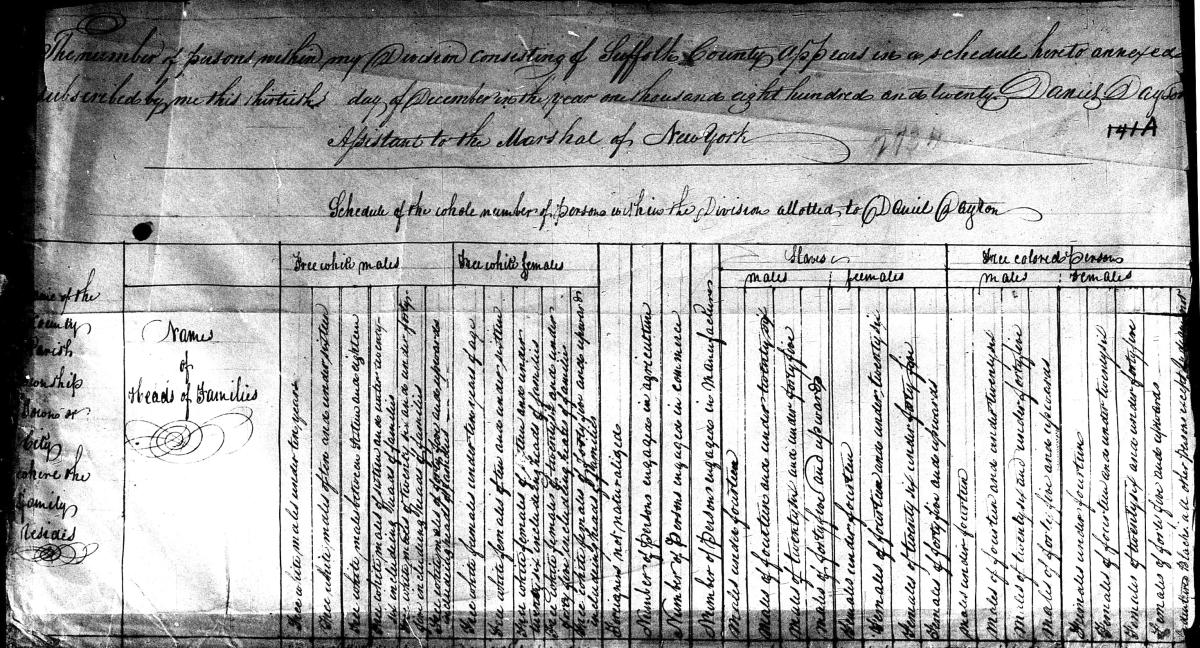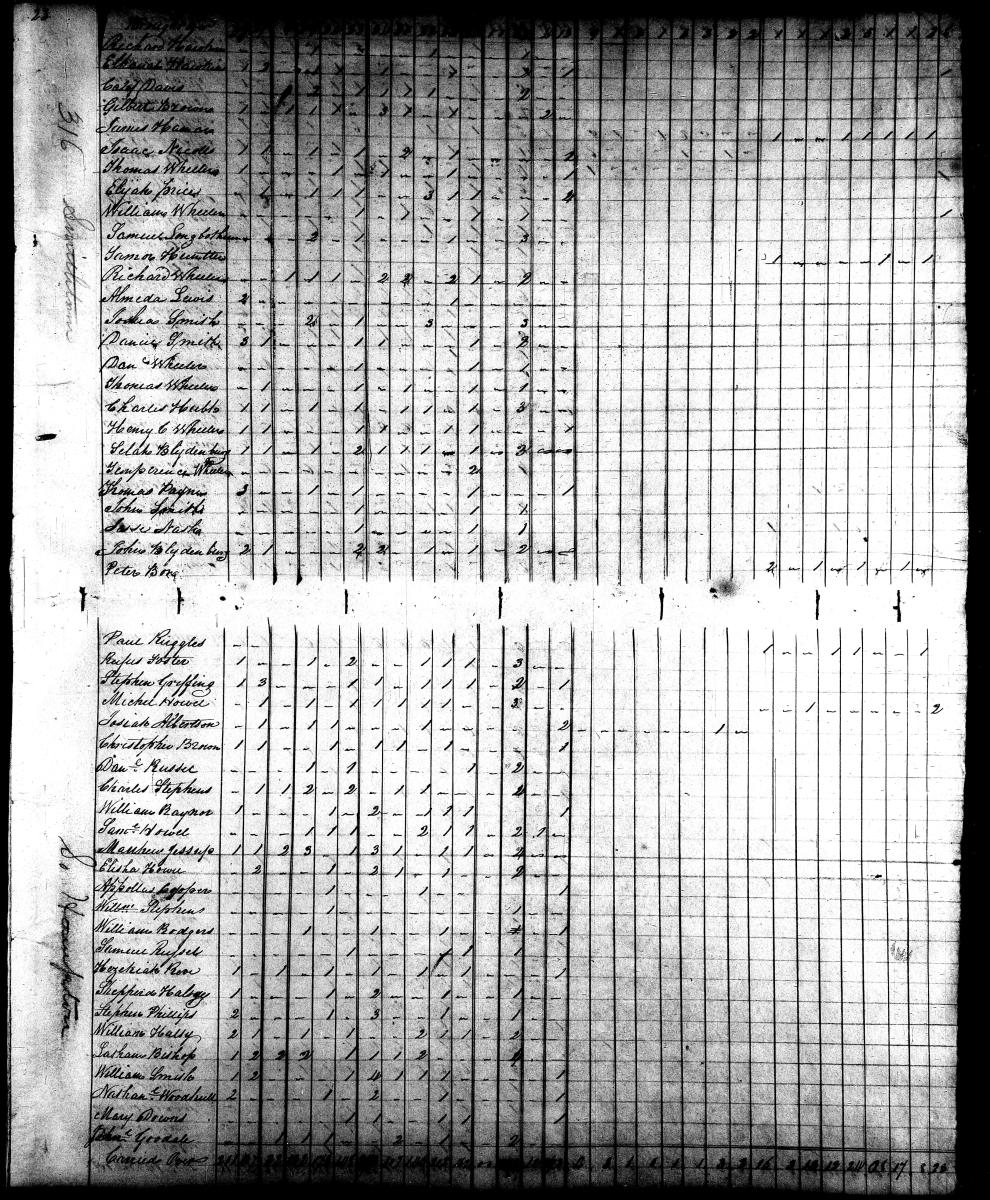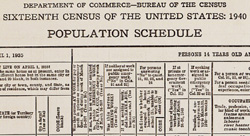
1820 Census Records
The 1820 population census was the Fourth Decennial Census of the United States. Taken every 10 years since 1790, census records provide a snapshot of the nation's population.
Frequently Asked Questions About the 1820 Census
Why was the 1820 Census taken?
Article I, Section 2, of the U.S. Constitution established that representation in the U.S. House of Representatives was based on population determined by a census taken at 10 year intervals: "The actual Enumeration shall be made within three Years after the first Meeting of the Congress of the United States, and within every subsequent Term of ten Years, in such Manner as they [Congress] shall by Law Direct."
What was the official census day?
Monday, August 7, 1820.
When was it taken?
The census began on Monday, August 7, 1820, and was finished within 6 months, under the rules and directions established in an Act of Congress approved March 14, 1820 ( “An Act to provide for taking the fourth census, enumeration of the Inhabitants of the United States, and for other purposes,” 3 Statutes at Large 553).
Who was counted?
The law required "That every person whose usual place of abode shall be in any family, on [August 7, 1820], shall be returned as of such family; and the name of every person, who shall be an inhabitant of any district or territory, without a settled place of residence, shall be inserted in the column of the schedule which is allotted for the heads of families in the division where he or she shall be on [August 7, 1820]; and every person occasionally absent at the time of the enumeration, as belonging to that place in which he usually resides in the United States."
Who was involved?
- Secretary of State John Quincy Adams had general supervision of census operations and tabulating and reporting the results to the President and Congress.
- The U.S. Marshal for each Federal judicial district was responsible for taking the census in his district with the help of assistant marshals whom he appointed. Each took an oath or affirmation that "I will well and truly cause to be made, a just and perfect enumeration and description of all persons resident within my district or territory, ... and return the same to the Secretary of State, agreeably to the directions of an act of Congress, entitled, 'An act to provide for taking the fourth census or enumeration of the inhabitants of the United States, and for other purposes,' according to the best of my ability." For unknown reasons, Congress decided it was necessary to specify that "... the said enumeration shall be made by an actual inquiry at every dwelling-house, or of the head of every family, and not otherwise."
- Every person over age 16 was required to cooperate: "That each and every person more than sixteen years of age, whether heads of families or not ... shall be, and hereby is, obligated to render to the assistant [marshal] ... if, required, a true account, to the best of his or her knowledge, of every person belonging to such family ... on pain of forfeiting twenty dollars...."
What questions did the census ask?
- Name of head of family
- Number of free white males under 10 years of age
- Number of free white males of 10 and under 16 years of age
- Number of free white males between 16 and 18 years of age
- Number of free white males of 16 and under 26 years of age
- Number of free white males of 26 and under 45 years of age
- Number of free white males 45 years old and upwards
- Number of free white females under 10 years of age
- Number of free white females of 10 and under 16 years of age
- Number of free white females of 16 and under 26 years of age
- Number of free white females of 26 and under 45 years of age
- Number of free white females 45 years old and upwards
- Number of foreigners not naturalized
- Number of persons engaged in agriculture
- Number of persons engaged in commerce
- Number of persons engaged in manufactures
- Number of male slaves under 14 years of age
- Number of male slaves of 14 and under 26 years of age
- Number of male slaves of 26 and under 45 years of age
- Number of male slaves 45 years old and upwards
- Number of female slaves under 14 years of age
- Number of female slaves of 14 and under 26 years of age
- Number of female slaves of 26 and under 45 years of age
- Number of female slaves 45 years old and upwards
- Number of male free colored persons under 14 years of age
- Number of male free colored persons of 14 and under 26 years of age
- Number of male free colored persons of 26 and under 45 years of age
- Number of male free colored persons 45 years old and upwards
- Number of female free colored persons under 14 years of age
- Number of female free colored persons of 14 and under 26 years of age
- Number of female free colored persons of 26 and under 45 years of age
- Number of female free colored persons 45 years old and upwards
- Number of all other persons, except Indians not taxed
What did the census form look like?
The Federal Government did not provide blank printed forms to the U.S. Marshals. Uniform printed forms were used only if supplied by the U.S. Marshal at his own expense to his assistants. Otherwise, the assistant marshals used whatever paper was available and recorded the information by hand in the format required by Congress shown below. In addition, there may be annotations such as certificates of oaths taken and population totals. Later annotations include handwritten and mechanically-stamped page numbers. The column headings are usually found only on the first page of the assistant marshal's district. The following image shows the handwritten census form used in Suffolk County, New York:
The assistant marshals usually omitted the columns for enumerating enslaved inhabitants in locations where slavery was illegal, such as this form used in Geauga County, Ohio:
This is the 1820 census form printed by the Congressional printer with the Act of Congress that directed the taking of the 1820 census. However, the printer made certain errors that are noted in the caption!
Caution!
Some of the assistant marshals - such in Suffolk County, New York - used large sheets of paper that were folded and bound into "books." Later, in the early 1900s, when the Census Bureau re-bound the census in a uniform manner, they unbound the original books. This unfortunately, essentially destroyed the original order of the census pages so that pages from different towns were intermixed. In 1959, the National Archives microfilmed the 1820 census as bound by the Census Bureau. As a result, in many places, including Suffolk County, New York, the top portion of the page is for one town while the bottom portion of the page is for another town!
What states are included in the census?
Surviving records include census schedules for Connecticut, Delaware, District of Columbia, Georgia, Illinois, Indiana, Kentucky, Maine, Maryland, Massachusetts, Michigan, Mississippi, New Hampshire, New York, North Carolina, Ohio, Pennsylvania, Rhode Island, South Carolina, Tennessee, and Vermont. Special notes:
- Alexandria County, Virginia, was part of the District of Columbia
- West Virginia was part of Virginia
Are some 1820 census records missing?
Yes. There are no schedules for:
- Arkansas Territory
- Georgia counties of Columbia (part), Franklin, Rabun, and Twiggs
- Indiana county of Davies
- Maine county of Washington is missing Houlton and North Limerick
- Missouri Territory
- New Hampshire counties of Grafton (entire); Rockingham (Gosport, Greenland, New Castle, Newington, Portsmouth, and Rye); Strafford County (except Centre Harbor, Gilford, Moultonborough, New Hampton, and Sanbornton). Coos County censuses may be incomplete before 1850 because many residents of northern Coos County considered themselves within Canadian jurisdiction before the U.S.-Canada boundary dispute was settled in 1842.
- New Jersey
- North Carolina counties of Currituck, Franklin, Martin, Montgomery, Randolph, and Wake
- Ohio counties of Franklin and Wood
- Tennessee counties of Anderson, Bledsoe, Blount, Campbell, Carter, Claiborne, Cocke, Grainger, Greene, Hamilton, Hawkins, Jefferson, Knox, McMinn, Marion, Monroe, Morgan, Rhea, Roane, Sevier, Sullivan, and Washington
Under the provisions of the 1820 census act, only numerical population totals were forwarded by the U.S. Marshals and Secretaries of the territories to the Secretary of State. From 1790 to 1820, the original population schedules were to be deposited with the clerks of district courts (or superior courts in the territories), "who were to receive and carefully preserve the same." On May 28, 1830, a Congressional resolution (4 Statutes at Large 430), directed the clerks of the district courts to forward the population schedules for the first four censuses to the Secretary of State. It is known that the 1790 schedules for Rhode Island were forwarded to Washington on June 22, 1830, as a result of the May 28 resolution. Presumably other extant population schedules, 1790-1820, were forwarded at about the same time, but no documentation of such action has been found. It is possible that individual census pages for other locations were lost between 1830 and when they were bound in volumes in the early 1900s.
Where can I see the original 1820 census schedules?
Digital images of National Archives Microfilm Publication M33, Fourth Census of the United States, 1820 (142 rolls), can be seen on popular genealogy websites, including Ancestry.com, FamilySearch.org, and others. When M33 was microfilmed, however, nine Virginia pages were accidentally missed. The missing pages were from seven different counties (Accomack, Monongalia, Prince Edward, Pittsylvania, Randolph, Shenandoah, and Southampton), and reference over 175 individuals. These names are listed in Gerald M. Petty, "Virginia 1820 Federal Census: Names Not on the Microfilm Copy," The Virginia Genealogist, Vol. 8, No 2. (April-June 1974): 136-139. The article includes the names, county, and page number references for those who were missed.
PDF files require the free Adobe Reader.
More information on Adobe Acrobat PDF files is available on our Accessibility page.






